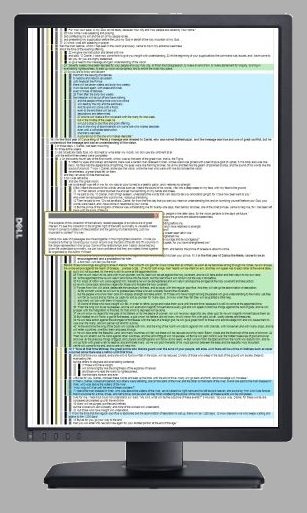Interactive Content - Introduction and Catalog
Interactive Exhibits of Thematic Structure
Exodus 26:1-27:18 - Building the Tabernacle and the Court
1 Kings 18-19 (1 of 3 - the framework)
Isaiah 38 - The Sign to Hezekiah
Matthew 24 (Greek [UBS5] side-by-side with NASB)
Luke 17:5-19 "Increase our faith"
John 19:16b-20:31 - Crucifixion, Death, Burial and Resurrection
John 21 - Resurrection Secrets
The Book of Romans and its exquisite wrapper!
Romans 1:17-32 (including Romans 12:1-2)
Romans 11 (including Romans 15:8-12)
1 Corinthians 15 (Greek [UBS5] side-by-side with YLT)
1 Thessalonians 4:1-5:22 (legacy version)
II Thessalonians 2:1-12 & 3:6-15 (Companion Bible)
Revelation Chapters 4 through 11
Revelation Chapters 12 through 14
Revelation 13 * as an 11+11 parallelism
Revelation 14:1-5 * as a parallelism
The Chiasmatron 2000 was used to develop these studies and generate the interactive versions for presentation.
Welcome to this introduction to the remarkable structure of the biblical text, with a catalog of all of our unique interactive studies!
Have you ever noticed that there seems to be a lot of repetition in the Bible? In some places, the language seems to be excessively verbose or unnecessarily repetitive. Have you ever wondered why that might be? There's a very good reason for it!
While the Author does imbue the holy scriptures with a poetic or lyrical quality, this is more than just a matter of aesthetics. By means of repeating words and themes, linguistic patterns are generated that are filled with meaning. These structural patterns are symmetrical and they exist across the entire range of the Holy scriptures, from Genesis 1:1 to Revelation 22:21. This phenomenon exists in the Hebrew, Aramaic, and Greek language texts, and it even survives translation into other languages! Any solid and fairly literal version exhibits even a very granular architecture.
There is a high degree of organization to the Author's design. His way is to communicate through patterns. Those who study His works in the natural or physical realm learn by finding and closely examining the patterns that manifest in the structure of things and the relationships between things. Those with similar wisdom, who study His word, do likewise.
Linguistic patterns appear as the words and phrases express thematic elements that are repeated at least once. The repetition typically occurs in the very local context and then also in more remote contexts. These patterns are symmetrical, and while there are only three distinct forms, each form has variants. Fundamentally, this is very simple. A theme may be presented and then repeated, once, or perhaps even two or more times. More commonly, a series of two or more elements is repeated, either in the same order or in the reverse order. In the scholarly community, the linguistic patterns are generally referred to as chiasm (or chiasmus) and parallelism. While being very simple in their basic expression, there's plenty of complexity and subtlety and nuance in their expression because the forms and their varieties are woven together in many different ways. Additionally, multiple levels of interpretation may be discerned that cross through different levels or different scales of the highly organized biblical text.
The derivation of meaning from these linguistic patterns comes through an improved knowledge of the context. Context is: "The part of a text or statement that surrounds a particular word or passage and determines its meaning". (American Heritage Dictionary of the English Language) When you can discern the symmetrical structure of a passage, this level of precision enhances your knowledge of the context as a guide to gleaning more insight into the meaning. Each pairing presents a kind of equation that says: "These expressions are equivalent. They compare in some way." Each component in a pairing shines its light upon its thematic companion or companions!
Additionally, more can be learned from being able to identify where the Author has placed emphasis. In the inverted form known as a chiasmus, emphasis is placed on the inner pairing that the structure pivots around. When the structure of a passage has some characteristic style of form or combination, anything that deviates from that draws our special attention. The more unusual or rare that feature is, the more emphasis it receives.
Any thematic pairing that seems immediately obvious assures us that we have identified a match, but many of the comparisons are quite subtle! If, after having confidently discovered the Author's design, the theme or themes of some particular pairing is unrecognizable, a student is required, or, shall we say, invited, to passionately seek out whatever it is that the Author has concealed which He might be blessed to reveal. Very surprising and sometimes very profound insights may be discovered thereby!
Additional Resources
See also this page explaining more about patterns inherent in the biblical text: Bible Code Revelations
YouTube Channel: These Patterns are Amazing
→ Playlist: Primer on Interactive Structures and Thematic Symmetry (Chaism) in the Bible
→ Playlist: Interactive Structures from 1 Kings 18-19
→ Playlist: Interactive Structures from the Gospel of John
Here, you'll find some studies where interactive presentations are leveraged to complement the teaching.
→ Headcovering (1 Corinthians 11:1-17)
→ Propriety in the Assembly of the Saints (1 Timothy 2)
→ The Sign for the Bride - Part 1 (2 Thessalonians 2:1-12)
→ Joseph and Benjamin - Part II (Genesis 45:4-9)
→ Passing Through the Iron Gate (Acts 12:1-19)
→ The Pending Reset of Time (John 18:2-8a)